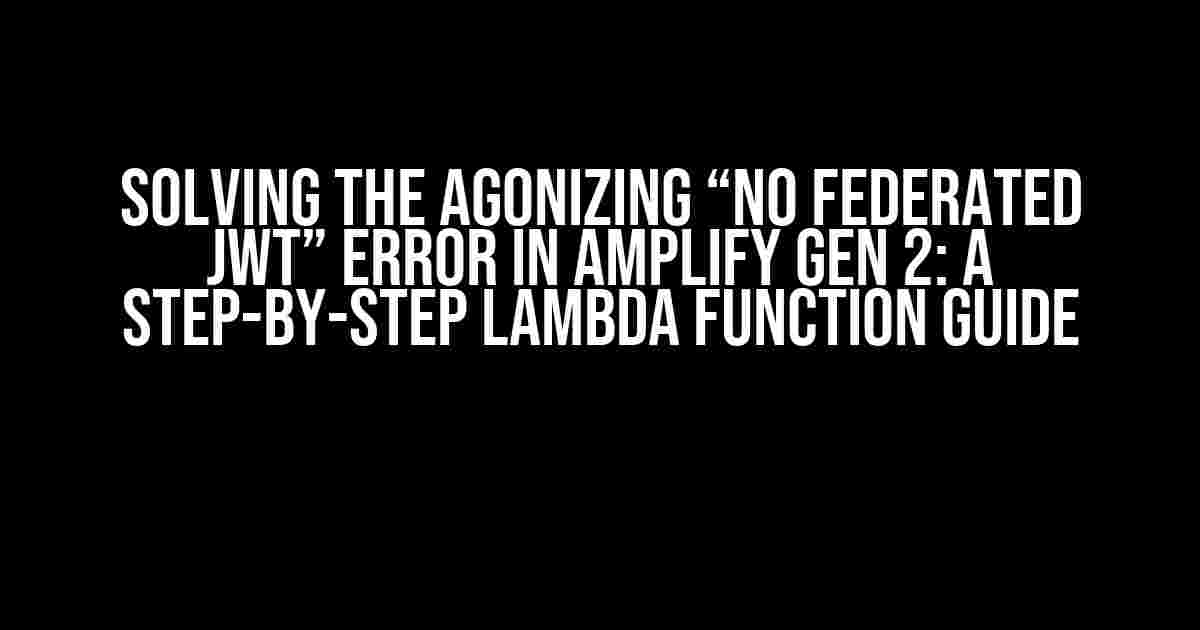Are you tired of encountering the infuriating “No federated JWT” error in your Amplify Gen 2 project? Do you feel like pulling your hair out every time you see this error message? Worry no more, dear developer! In this comprehensive guide, we’ll walk you through the process of resolving this pesky error and get your lambda function up and running in no time.
What Causes the “No Federated JWT” Error?
Before we dive into the solution, it’s essential to understand the root cause of this error. The “No federated JWT” error occurs when your lambda function is unable to authenticate with the Amplify Gen 2 API. This can happen due to various reasons, including:
- Incorrectly configured AWS IAM roles and permissions
- Mismatched or missing AWS_REGION and AWS_ACCESS_KEY_ID environment variables
- Incorrect or expired AWS credentials
- Invalid or missing JWT token in the authorization header
Step 1: Verify Your AWS IAM Roles and Permissions
The first step in resolving the “No federated JWT” error is to ensure that your AWS IAM roles and permissions are correctly configured. Follow these steps to verify your IAM setup:
- Log in to the AWS Management Console and navigate to the IAM dashboard.
- Click on “Roles” and select the role associated with your lambda function.
- Click on the “Permissions” tab and ensure that the role has the necessary permissions to execute your lambda function.
- Check if the role has the “execute-api” permission on the API Gateway.
{
"Version": "2012-10-17",
"Statement": [
{
"Sid": "AllowAPICalls",
"Effect": "Allow",
"Action": "execute-api:Invoke",
"Resource": "arn:aws:execute-api:REGION:ACCOUNT_ID:API_ID/*"
}
]
}
Step 2: Configure Your Lambda Function Environment Variables
The next step is to ensure that your lambda function environment variables are correctly configured. Follow these steps to set up your environment variables:
- In the AWS Lambda console, click on your lambda function and navigate to the “Configuration” tab.
- Click on “Environment variables” and add the following variables:
| Variable Name | Value |
|---|---|
| AWS_REGION | Your AWS region (e.g., us-east-1) |
| AWS_ACCESS_KEY_ID | Your AWS access key ID |
| AWS_SECRET_ACCESS_KEY | Your AWS secret access key |
Step 3: Verify Your AWS Credentials
Ensuring that your AWS credentials are correct and up-to-date is crucial for resolving the “No federated JWT” error. Follow these steps to verify your AWS credentials:
- Check if your AWS access key ID and secret access key are correct and not expired.
- Verify that your AWS credentials are properly configured in your AWS CLI or SDK.
aws sts get-caller-identity
Step 4: Verify Your JWT Token
The final step is to ensure that your JWT token is valid and correctly configured. Follow these steps to verify your JWT token:
- In your lambda function, verify that the authorization header contains a valid JWT token.
- Check if the JWT token is correctly signed and verified by your lambda function.
const jwtToken = event.headers.Authorization; const decodedToken = jwt.verify(jwtToken, process.env.ISSUER_KEY);
Conclusion
In conclusion, resolving the “No federated JWT” error in Amplify Gen 2 requires careful attention to detail and a thorough understanding of the underlying causes. By following the steps outlined in this guide, you should be able to resolve this error and get your lambda function up and running in no time. Remember to:
- Verify your AWS IAM roles and permissions
- Configure your lambda function environment variables
- Verify your AWS credentials
- Verify your JWT token
By following these steps and taking the necessary precautions, you’ll be well on your way to resolving the “No federated JWT” error and building a robust and secure Amplify Gen 2 project. Happy coding!
Frequently Asked Question
Stuck with the “No federated JWT” error in your Amplify Gen 2 lambda function? We’ve got you covered! Check out these FAQs to troubleshoot the issue and get your app up and running smoothly.
Why am I getting a “No federated JWT” error in my Amplify Gen 2 lambda function?
This error usually occurs when there’s an issue with the authentication flow or the JWT token is not being passed correctly to your lambda function. Make sure you’ve correctly configured your Amplify auth module and that the `aws_amplify_auth_token` is being passed as an event object to your lambda function.
How do I verify that the `aws_amplify_auth_token` is being passed correctly to my lambda function?
You can check the CloudWatch logs for your lambda function to ensure that the `aws_amplify_auth_token` is being passed as an event object. You can also use a debugger or logs to verify that the token is being received by your lambda function and that it’s not empty or undefined.
What are some common reasons why the `aws_amplify_auth_token` might not be passed correctly to my lambda function?
Some common reasons include incorrect authentication module configuration, missing or invalid AWS credentials, or issues with the JWT token itself. Double-check your auth module configuration, ensure that your AWS credentials are correct, and verify that the JWT token is being generated correctly.
Can I use a third-party authentication provider with Amplify Gen 2?
Yes, Amplify Gen 2 supports third-party authentication providers such as Google, Facebook, and Amazon. However, you’ll need to ensure that the authentication flow is correctly configured and that the JWT token is being generated and passed correctly to your lambda function.
Where can I find more resources to help troubleshoot the “No federated JWT” error in my Amplify Gen 2 lambda function?
Check out the official Amplify documentation, AWS documentation, and online forums such as the AWS Amplify community and Stack Overflow. You can also seek help from AWS support or a professional developer if you’re still stuck.
